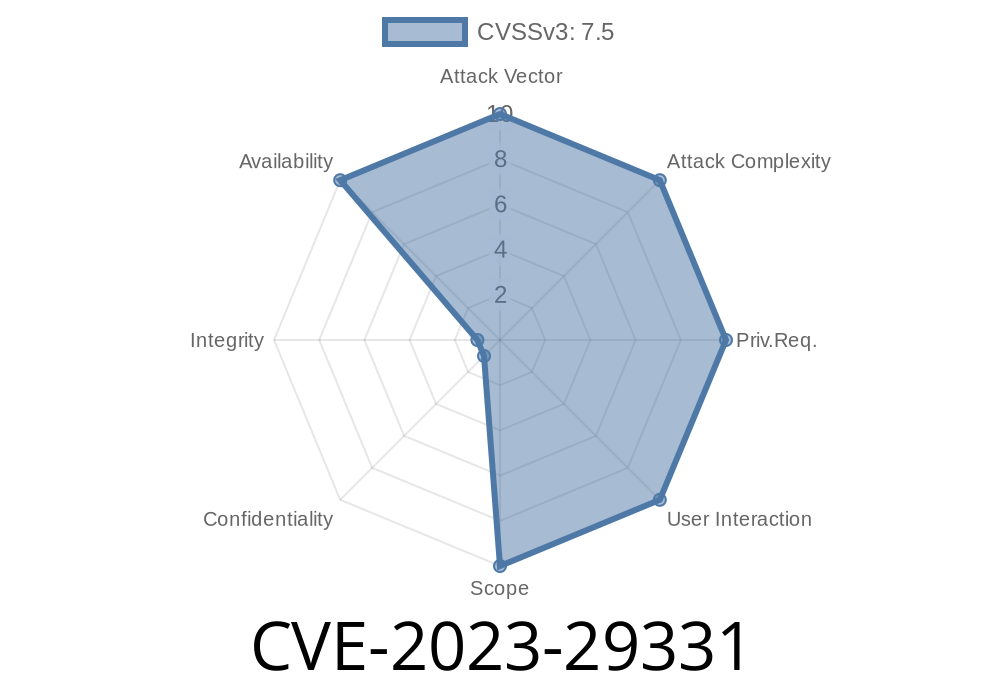In May 2023, Microsoft published a security advisory addressing CVE-2023-29331 – a denial of service (DoS) vulnerability affecting .NET, .NET Framework, and Visual Studio. While it sounds technical, this issue could let an attacker crash your application or development environment with a specially crafted input. Below, I’ll break down what happened, how attackers can exploit this, and how you can protect your software.
What is CVE-2023-29331?
This CVE is a Denial of Service (DoS) vulnerability. Basically, this bug means a malicious user can cause your .NET application (from ASP.NET web apps to WPF desktop apps), or even Visual Studio itself, to crash or freeze.
Microsoft described it as
> *"A vulnerability exists in .NET and Visual Studio where improper input validation can lead to denial of service via excessive resource consumption or application crash."*
Vulnerable products include
- .NET 6./7. (and some older versions)
References
- Microsoft Security Advisory
- NVD Details (NIST)
- .NET GitHub Issue (related community discussion)
How Does the Vulnerability Work?
At its core, this is a resource exhaustion attack – the attacker sends specially crafted data to a function in the .NET runtime which mishandles it, causing:
Example: Dangerous API Usage
Let me show you a code snippet that demonstrates a DOS risk. It isn’t the exact vulnerable code, but it shows the kind of thing that could go wrong.
Sample Vulnerable Code
// Example: reading a very large or malformed file
public string ReadUserFile(string filePath)
{
// Does not validate file size
return File.ReadAllText(filePath); // Could hang or crash on huge files!
}
If an attacker supplies a gigabyte-sized file, your app could run out of memory and crash.
Threat Model
- Attacker’s Goal: Knock your web server, API, or desktop app offline by slowing it down or crashing it.
Proof-Of-Concept
Let’s say your web API parses JSON uploads with no size limit. The attacker uploads a maliciously huge or deeply nested JSON to an endpoint like this:
[HttpPost]
public IActionResult UploadData([FromBody] MyModel model)
{
// Some business logic
return Ok();
}
If the .NET JSON parser prior to the patch didn’t limit depth or size, it could hang or crash.
Payload Example (Pseudo-JSON)
{"a":{"a":{"a":{"a": ... repeat thousands of times ... }}}}
Result:
Example Fix: With Input Size Check
public string ReadUserFileSafe(string filePath)
{
var info = new FileInfo(filePath);
if (info.Length > 1024*1024) // e.g., 1 MB limit
throw new InvalidOperationException("File too large");
return File.ReadAllText(filePath);
}
Conclusion
CVE-2023-29331 is a critical reminder: even big frameworks like .NET can have simple bugs with big impact. As a developer or sysadmin, patch early, and remember to never trust user input!
More Reading
- Microsoft Technical Blog on .NET Security
- CVE-2023-29331 at Microsoft
Stay safe, keep your systems up to date, and help your users avoid downtime!
*Exclusive content for security-minded developers. Please share with your team and double-check your dependencies for this patch.*
Timeline
Published on: 06/14/2023 15:15:00 UTC
Last modified on: 06/22/2023 20:10:00 UTC
